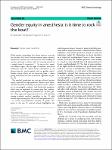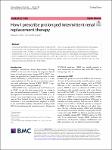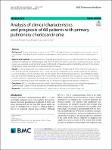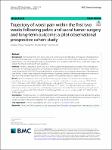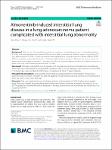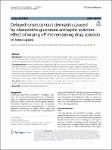Search
Author
- Osman, Ahmed I. (5)
- Daqing, Ma (3)
- Jorgensen, Ed (3)
- Li, Yan (3)
- next >
Subject
- kinh tế (26)
- Economics (12)
- programming (10)
- XRD (10)
- next >
Date issued
- 2020 - 2025 (2129)
- 2010 - 2019 (129)
- 2000 - 2009 (9)
- 1999 - 1999 (1)
Has File(s)
Search Results
While gender inequalities have been reduced over the last decades, the United Nations women’s report recently showed that women are still restricted from working in certain industries in almost 50% of countries (based on a sample from 93 countries) [1]. On top of that, essential women’s rights, like the right to abortion, have been withdrawn from the United States constitution [2, 3], obstructing the much-needed road to gender equity. Gender equity, which we are discussing here, is about giving everybody the tools to succeed regardless of gender [4]. |
Prolonged Intermittent Renal Replacement Therapy (PIRRT) is the term used to define ‘hybrid’ forms of renal replacement therapy. PIRRT can be provided using an intermittent hemodialysis machine or a continuous renal replacement therapy (CRRT) machine. Treatments are provided for a longer duration than typical intermittent hemodialysis treatments (6–12 h vs. 3–4 h, respectively) but not 24 h per day as is done for continuous renal replacement therapy (CRRT). Usually, PIRRT treatments are provided 4 to 7 times per week. PIRRT is a cost-effective and flexible modality with which to safely provide RRT for critically ill patients. We present a brief review on the use of PIRRT in the ICU with a focus on how we prescribe it in that setting. |
Primary pulmonary choriocarcinoma (PPC) is a highly malignant intrapulmonary tumor with a notorious prognosis. Few clinical studies have been undertaken to investigate the clinical characteristics and prognosis of PPC. |
This open access book offers an initial introduction to programming for scientific and computational applications using the Python programming language. The presentation style is compact and example-based, making it suitable for students and researchers with little or no prior experience in programming.
The book uses relevant examples from mathematics and the natural sciences to present programming as a practical toolbox that can quickly enable readers to write their own programs for data processing and mathematical modeling. These tools include file reading, plotting, simple text analysis, and using NumPy for numerical computations, which are fundamental building blocks of all programs in data science and computational science. At the same time, readers are introduced to the fun... |
This open access book presents a systematic investigation into internationally comparable data gathered in ICILS 2013. It identifies differences in female and male students’ use of, perceptions about, and proficiency in using computer technologies. Teachers’ use of computers, and their perceptions regarding the benefits of computer use in education, are also analyzed by gender.
When computer technology was first introduced in schools, there was a prevailing belief that information and communication technologies were ‘boys’ toys’; boys were assumed to have more positive attitudes toward using computer technologies. As computer technologies have become more established throughout societies, gender gaps in students’ computer and information literacy appear to be closing, although st... |
Pain management after pelvic and sacral tumor surgery is challenging and requires a multidisciplinary and multimodal approach. Few data on postoperative pain trajectories have been reported after pelvic and sacral tumor surgery. The aim of this pilot study was to determine pain trajectories within the first 2 weeks after surgery and explore the impact on long-term pain outcomes. |
To determine the diagnostic accuracy of a nanopore sequencing assay of PCR products from a M. tuberculosis complex-specific region for testing of bronchoalveolar lavage fluid (BALF) samples or sputum samples from suspected pulmonary tuberculosis (PTB) patients and compare the results to results obtained for MGIT and Xpert assays. |
With the use of targeted drugs in lung cancer patients, targeted drug-induced interstitial lung disease (ILD) has attracted more and more attention. The incidence, time, and severity of different targeted drug-induced ILD vary. Almonertinib/HS-10296 is a third-generation epidermal growth factor receptor-tyrosine kinase inhibitor (EGFR-TKI). Post-marketing safety and effectiveness of almonertinib have been confirmed. The reported adverse events of almonertinib were mainly an increase in creatine phosphokinase, aspartate aminotransferase, and alanine aminotransferase, and onset of rash. Almonertinib-induced ILD is rare. |
Caudal epidural block (CEB) is a kind of epidural anesthesia in which local anesthesia is injected through the sacral hiatus into the sacral epidural space to block the sacral nerve and temporarily paralyze the area it controls [1]. CEB may be beneficial in anorectal surgery because its use may extend postoperative analgesia, which reduce the need for systemic analgesics and their potential side effects [2, 3]. Although CEB has many clinical applications, it is sometimes difficult to ascertain the anatomical location of the sacral hiatus and the caudal epidural space, particularly in adults [4, 5]. |
Olanexidine glucuronide (Olanedine®), an antiseptic solution may cause skin dermatitis around one week after disinfection. Although removal after the procedure is recommended to avoid skin dermatitis, whether it is effective for preventing skin dermatitis has not been documented in detail in the literature. |

